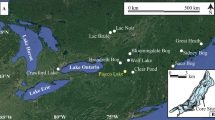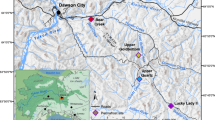Abstract
A 2 m sediment core from Church's Blue Hole on Andros Island, Bahamas provides the first paleoecological record from the Bahama Archipelago. The timing of events in the lower portion of the core is uncertain due to inconsistencies in the radiocarbon chronology, but there is evidence that a late Holocene dry period altered the limnology of Church's Blue Hole and supported only dry shrubland around the site. The dry period on Andros may correlate with a widespread dry period in the Caribbean from 3200 to 1500 yr BP. After the dry period ended, a more mesic climate supported tropical hardwood thicket around Church's Blue Hole. At c. 740 radiocarbon yr BP there is a sudden rise in charcoal concentration and a rapid transition to pinewoods vegetation, while at c. 430 radiocarbon yr BP charcoal concentration drops, but is higher again near the top of the core. Although climatic shifts could have caused these changes in vegetation and charcoal concentration, the changes post-date human colonization of the Bahamas and may reflect human arrival, followed by the removal of humans c. 1530 AD and the recolonization of Andros Island c. 200 years later.
Similar content being viewed by others
References
Berman, M. J. & P. L. Gnivecki, 1994. The colonization of the Bahama Archipelago: A reappraisal. World Archaeology 26: 421–441.
Binford, M. W., M. Brenner, T. J. Whitmore, A. Higuera-Gundy, E. S. Deevey & B. Leyden, 1987. Ecosystems, paleoecology and human disturbance in subtropical and tropical America. Quat. Sci. Rev. 6: 115–128.
Boardman, M. R., A. C. Neumann & K. A. Rasmussen, 1989. Holocene sea level in the Bahamas. In J. E. Mylroie (ed), Proc. of the Fourth Symp. of the Geol. of the Bahamas, Bahamian Field Station, San Salvador, Bahamas 45–52.
Brenner, M. & M. W. Binford, 1988. A sedimentary record of human disturbance from Lake Miragoane, Haiti. J. Paleolim 1: 85–97.
Brown, G. B. & A. D. Cohen, 1985. Palynologic and petrographic analyses of peat deposits, Little Salt Spring. Nat. Geog. Res. Winter. 1985.
Burney, D. A., 1987. Late Quaternary stratigraphic charcoal records from Madagascar. Quat. Res. 28: 274–280.
Burney, D. A., 1993. Late Holocene environmental changes in arid southwestern Madagascar. Quat. Res. 40: 98–106.
Burney, D. A., L. P. Burney & R. D. E. MacPhee, 1994. Holocene charcoal stratigraphy from Laguna Tortuguero, Puerto Rico, and the timing of human arrival on the island. J. Arch. Sci. 21: 273–281.
Bush, M. B., D. R. Piperno & P. A. Colinvaux, 1989. A 6000 year history of Amazonian maize cultivation. Nature. 340: 303–305.
Bush, M. B., D. R. Piperno, P. A. Colinvaux, P. E.De Oliviera, L. A. Krissek, M. C. Miller & W. E. Rowe, 1992. A 14300-yr paleoecological profile of a lowland tropical lake in Panama. Ecol. Monogr. 62: 251–275.
Bush, M. B. & P. A. Colinvaux, 1994. Tropical forest disturbance: Paleoecological records from Darien, Panama. Ecology 75: 1761–1768.
Byrne, R., 1980. Man and the variable vulnerability of island life. A study of recent vegetation change in the Bahamas. Atoll Res. Bull. no. 240.
Byrne, R. & S. Horn, 1989. Prehistoric agriculture and forest clearance in the Sierra de Los Tuxtlas, Veracruz, Mexico. Palynology 13: 181–193.
Correll, D. S. & H. B. Correll 1982. Flora of the Bahama Archipelago. Lubrecht and Cramer, Forestburgh, New York.
Deevey, E. S., D. S. Rice, P. M. Vaughan, M. Brenner & M. S. Flannery, 1979. Mayan urbanism: Impact on a tropical karst environment. Science 206: 299–306.
Deevey, E. S., M. Brenner & M. W. Binford, 1983. Paleolimnology of the Peten Lake district, Guatemala. III. Late Pleistocene and Gamblian environments of the Maya area. Hydrobiologia 103: 211–216.
Dodge, S., 1983. Abaco: the story of an out island and its cays. Tropic Isle Publication, Inc., North Miami, Florida.
Faegi, K. & J. Iversen, 1989. A textbook of pollen analysis. John Wiley and Sons, New York.
Gleason, P. J. & P. Stone, 1994. Age, origin, and landscape evolution of the Everglades peatland. In S. M. Davis & J. C. Ogden (eds), Everglades: The Ecosystem And Its Restoration, St. Lucie Press, Delray Beach, Florida.
Goggin, J. M., 1939. An anthropological reconnaissance of Andros Island, Bahamas. American Antiquity 5: 21–26.
Goman, M., 1992. Paleoecological evidence for prehistoric agriculture and tropical forest clearance in the Sierra de Los Tuxtlas, Veracruz, Mexico. Unpublished Master's thesis. Univ. of Calif. Berkeley.
Greaves, A., 1978. Descriptions of seed sources and collections for tropical provenances of Pinus caribaea. Tropical Forestry Paper # 12. Unit of Tropical Silviculture. Commonwealth Forestry Institute. University of Oxford, England.
Hodell, D. A., J. H. Curtis, G. A. Jones, A. Higuera-Gundy, M. Brenner, M. W. Binford & K. T. Dorsey, 1991. Reconstruction of Caribbean climate change over the past 10 500 years. Nature 352: 790–793.
Horn, S. P. & R. L. SanfordJr, 1992. Holocence fires in Costa Rica Biotropical 24: 354–361.
Keegan, W. F. & R. J. DeNiro, 1988. Stable carbon-and nitrogen-isotope ratios of bone collagen used to study coral-reef and terrestrial components of prehistoric Bahamian diet. American Antiquity 53: 320–337.
Keegan, W. F., 1992. The people who discovered Columbus: The prehistory of the Bahamas. The Ripley P. Bullen series/Florida Museum of Natural History. University Press of Florida: Gainsville.
Kjellmark, 1995. The effects of late Holocene climate change and human disturbance on the vegetation and fire history of Andros Island, Bahamas. PhD dissertation, Duke University.
Lamb, A. F. A., 1973. Fast growing timber trees of the lowland tropics number 6: Pinus caribaea, vol. 1 Unit of Tropical Silviculture, Department of Forestry, Oxford, England.
Leyden, B. W., 1987. Man and climate in the Maya lowlands. Quat. Res. 28: 407–414.
Mann, C. J., 1986. Composition and origin of material in pre-Columbian pottery, San Salvador, Bahamas. Geoarchaeology 1: 183–194.
March, E. W., 1949. Pine forests of the Bahamas. Empire Forestry Review 28: 33–37.
O'Hara, S. L., F. A. Street-Perrott & T. P. Burt, 1993. Accelerated soil erosion around a Mexican highland lake caused by prehistoric agriculture. Nature 362: 48–51.
Riley, S., 1983. Homeward bound: A history of the Bahama Islands to 1850 with a definitive study of Abaco in the American Loyalist Plantation Period. Miami, Florida: Island Research.
Rouse, I., 1989. Peopling and repeopling of the West Indies. In C. A. Woods (ed), Biogeography of the West Indies: Past, Present, and Future. Sandhill Crane Press, Inc., Coral Gables, Florida: 119–136.
Sears, W. H. & S. O. Sullivan, 1978. Bahamas prehistory. American Antiquity 43: 3–25.
Smith, I. K., 1991. Dry evergreen forest (coppice) communities of North Andros Island, Bahamas. Unpublished Master's thesis. Miami University, Oxford, Ohio.
Street-Perrott, F. A., P. E. Hales, R. A. Perrott, J. Ch. Fontes, V. R. Switzsur & A. Pearson, 1993. Late Quaternary paleolimnology of a tropical marl lake: Wallywash Great Pond. Jamaica J. Paleolimnol. 9: 3–22.
Stuiver, M. & P. J. Reimer, 1993. Extended 14C data base and revised CALIB 3.0 14C age calibration program. Radiocarbon 35: 215–230.
Traverse, A. & R. N. Ginsburg, 1966. Palynology of the surface sediments of the Great Bahama Bank, as related to water movement and sedimentation. Mar. Geol. 4: 417–459.
Watts, D., 1987. The West Indies: Patterns of development, culture and environmental change since 1492. Cambridge Univ. Press. Cambridge, England.
Watts, W. A. & J. P. Bradbury, 1982. Paleoecological studies at Lake Patzcuaro on the West-Central Mexican Plateau and at Chalco in the Basin of Mexico. Quat. Res. 17: 56–70.
Wiedemann, H. G., R. Riesen, A. Boller & G. Bayer, 1988. From wood to coal: A compositional thermogravimetric analysis. In C. M. Earnest (ed), Compositional analysis by thermogravimetry, ASTM STP 997. American Society for Testing Materials, Philadelphia 227–244.
Author information
Authors and Affiliations
Rights and permissions
About this article
Cite this article
Kjellmark, E. Late Holocene climate change and human disturbance on Andros Island, Bahamas. J Paleolimnol 15, 133–145 (1996). https://doi.org/10.1007/BF00196777
Received:
Accepted:
Issue Date:
DOI: https://doi.org/10.1007/BF00196777




